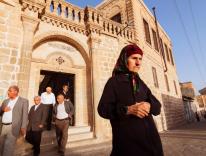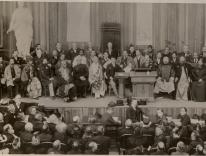When the Roman emperor Constantine moved his capital from Rome to Constantinople (modern-day Istanbul) in the early fourth century, he did so because he wanted to position his government more strategically at the crossroads of the known world. Of course, Constantine was more than a mere strategist; he was also the first Christian emperor and he privileged the faith through legislation, favorable tax policies, and the construction of spectacular cathedrals, including the Hagia Sophia. Perhaps no other building in the world so concretely stands at the intersection of East and West, just as no other building equally symbolizes the populist threat to religious minorities.
This is the third building on the site to be named “Hagia Sophia,” literally translated as “Holy Wisdom,” but understood by Christians to be a personification of Christ as Wisdom. The Constantinian church burned in the early fifth century, and the second church, like the first, was destroyed by fire in 532. But neither of those early structures, with their modest size and wooden roofs, could compare to the civilization-defining building commissioned by the emperor Justinian in 532 and opened in 537.
To say that the Hagia Sophia was the largest church in the world for a thousand years does not really do justice to its size, grandeur, or influence on subsequent Christian architecture. To say that the Hagia Sophia was the main cathedral of the Byzantine capital does not sufficiently convey the extent to which the church remains the single greatest symbol of an empire that lasted a thousand years, or a global Orthodox religious community that now exceeds 250 million people.
Hagia Sophia, like the city itself, has shifted hands many times since the Byzantines first worshiped there. From 1204 to 1261 it was under the control of the Crusaders, who installed their own clergy and performed the liturgy exclusively in the Latin Rite. A Byzantine army retook the city in 1261, but the Crusader colonization of the Christian East left the Byzantine world internally divided and economically devastated. In 1453, an Ottoman army led by Mehmed II conquered what was left of the empire. Mehmed moved quickly to transform Hagia Sophia into a mosque—removing the altar and plastering the iconography. Ottoman Istanbul soon became the political center of the Islamic world, and while the Ottomans would build many impressive mosques, none could compare to the Hagia Sophia in size or stature.
When the Ottoman Empire collapsed at the end of World War I, a new, highly secular government emerged in Turkey and its leader, Kemal Atatürk, converted the Hagia Sophia into a museum as part of a wide-ranging plan to break from the historic authority of Islam in Ottoman society. Atatürk was pro-West and secular, but he was also highly authoritarian and nationalistic. He advanced the myth of a pure “Turkish” identity that left little room for religious or cultural minorities. Armenians, Greeks, Jews, and Syrians had little space in Atatürk’s Turkey, despite the fact that these communities had been there for centuries before the first Turks had arrived.
In July, a Turkish court ruled that the Turkish government had overstepped its authority when it transformed Hagia Sophia from a mosque into a museum in 1935. As a consequence, the court ruled, Hagia Sophia should be returned to its “original” status as a mosque—a ruling that only makes sense with the erasure of Turkey’s Christian past after a century-long, state-sponsored propaganda campaign.
For most of the citizens of Turkey, the current dispute about the Hagia Sophia has very little to do with Christianity and everything to do with the legacy of Atatürk. Some Turkish Muslims, like President Recep Tayyip Erdoğan, believe that Atatürk’s actions vis-à-vis the Hagia Sophia constituted a disenfranchisement of the religious rights of Turkey’s Muslim majority, and Atatürk’s secular agenda was nothing other than Western colonialism designed to deprive Turkey of its authentic Muslim heritage. To their mind, Hagia Sophia is an Islamic structure rather than a Christian one. In large part, that view is predicated on a political theology that views military conquest as part of God’s providence.
Of course, not all Turks approve of Erdoğan’s religious populism or the decision to reconstitute Hagia Sophia as a mosque. Many view it as little more than an effort to shore up political support among religious conservatives in the face of growing political opposition across Turkey. For Turkey’s many secularists, the newest transformation of Hagia Sophia is a worrying development because it points to a gradual decline of secularism within Turkey, and raises the specter of the possibility of an Islamic populism like that of the Muslim Brotherhood.
So while Turkish society is very much divided over the court’s decision, very few in Turkey have given much thought as to what this suggests about the declining status of the nation’s religious minorities. To be sure, the forced conversion of the Hagia Sophia into a museum in 1935 may have transgressed the religious rights of some Turks, but it served a greater religious freedom goal by granting tacit recognition of Turkey’s Christian roots, as well as the continued presence of Christians in Turkey.
As a museum, the many layers of Hagia Sophia’s glorious past were opened to the world. Art historians and scholars of liturgy have been able to study the many ways in which believers decorated, moved, and worshiped within the largest sacred space in the Christian world for a thousand years. Imperial historians have gained a better understanding of the ways in which Christian governments both supported and were constrained by religious spaces. And the world was invited to visit one of the true wonders of human ingenuity—a space designed for the meeting of heaven and earth.
What will become of this space, which has served as a bridge between East and West unlike any other? And what will become of Turkey’s Christian minorities who, in many ways, play a similar role? What Turkish leadership comes after Erdoğan, whether allies like the United States continue to enable it, and how billions of people of faith respond will determine the answers.
Please email comments to [email protected] and join the conversation on our Facebook page.
Previous Story
Tranquility & Tempest
Next Story
Masks & Masculinity

